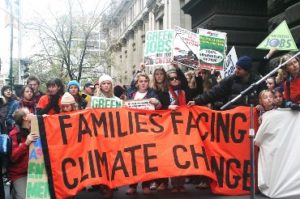Climate change after the pandemic
Human activity is primarily responsible for increased greenhouse emissions
John Quiggin

Even as the future of U.S. democracy remains in the balance, and as the pandemic still rages, I’m still working on my book The Economic Consequences of the Pandemic. At this stage, it’s hard to get a clear idea of how things will look when and if the viral pandemic is brought under control. One thing that is certain is that the serious problem of climate change/global heating will not have gone away.
The pandemic disaster has absorbed all of our attention. But the longer-running, and ultimately more dangerous disaster of global heating continues to wreak its ever-increasing havoc.
The hottest temperature ever reliably recorded (130 F or 54 C) was observed on Sunday August 16 2020, at Death Valley USA. Unsurprisingly the record temperatures gave rise to hundreds of disastrous fires throughout California The scale of the fires was described by the New York Times as ‘staggering; with 1.4 million acres burned by August. But this was not a once-off disaster.
Fires in 2017 set a new record for their extent and damage, only to be eclipsed by even worse disasters in 2018. The fires of 2019, which saw much of the electricity grid shut down for days on end and 250,000 acres burned, now seem mild by comparison.
This pattern is not unique to the USA. Massive fires have occurred from the Arctic to the Amazon. Over the southern hemisphere summer of 2019-20, my own country, Australia, experienced the worst bushfire season on record, with major cities blanketed in toxic smoke for weeks on end. Thirty-four people were killed by the fires them- selves, but hundreds more died from the acute effects of the smoke, and many more are likely to die of long-term effects. Humans weren’t alone. Nearly 3 billion animals were killed or displaced, with whole species facing extinction.
On the Atlantic coast of the USA, the climate drove a different kind of disaster. As has become normal experience in recent years, the first storms of the North Atlantic hurricane season arrived in May, before the official start of the season on June 1. In August, Hurricane Laura became the strongest on record (by windspeed) to make landfall in Louisiana, tying a record set in 1856.
Only the speed with which Laura moved inland prevented catastrophic damage on the scale seen with disasters like Katrina and Sandy. By mid-November, the 2020 season was declared the most active on record. There is now very strong evidence that climate change is causing more severe hurricanes, with heavier associated rainfall and rapid intensification.
As with the pandemic, we had plenty of warning about climate change. The science of global warming has been understood since the 19th century, and evidence that warming is taking place began to mount from the early 1980s. The Intergovernmental Panel on Climate Change was established in 1988, and produced its First Assessment Report in 1990, leading to the adoption of the United Nations Frame- work Convention on Climate Change.
The report established that global warming was taking place and that emissions resulting from human activities are substantially increasing the atmospheric concentrations of green- house gases: CO2, CH4, CFCs and N2O. These increases will enhance the greenhouse effect, resulting on average in an additional warming of the Earth’s surface. The main greenhouse gas, water vapour, will increase in response to global warming and further enhance it. However, considerable uncertainty remained regarding whether observed global warming was due to natural variability, human activity or some combination of the two.
The Second Assessment Report in 1995 presented stronger evidence that warming was being driven by green- house gas emissions. But already there was pressure from some governments to water down the conclusion.
A series of subsequent IPCC Assessment Reports has documented the increase in global temperatures and established, beyond any reasonable doubt, that human activity is primarily responsible. The most recent was the Fifth Assessment Report, released in 2014. The key finding:
Warming of the atmosphere and ocean system is unequivocal. Many of the associated impacts such as sea level change (among other metrics) have occurred since 1950 at rates unprecedented in the historical record. There is a clear human influence on the climate. It is extremely likely [probability greater than 95%] that human influence has been the dominant cause of observed warming since 1950,
Source: John Quiggin blog, 21 Nov 2020 https://johnquiggin.com/2020/11/21/climate-change-after-the-pandemic/



















